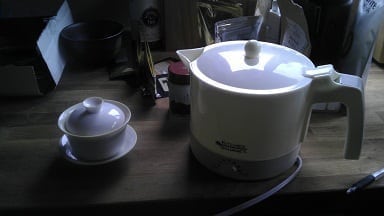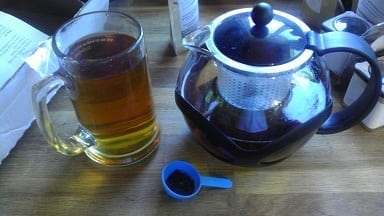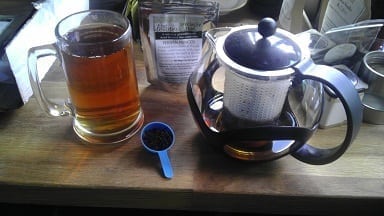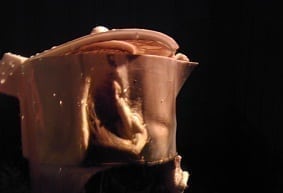This review is actually a sequel of sorts. To read its predecessor – for context – go HERE.
Don’t you hate it when you wake up in the morning and end up in another time period? So do I. As far as I know, it’s only happened once – today. I found myself awake at the ungodly hour of 7AM after hearing a loud gagging noise coming from my cat. That was usually the early warning sign of an impending (and rather messy) hairball.
After dealing with that little nuisance, I figured I might as well stay up and get some water boiling. It felt like an oolong morning, so – naturally – I went for the gaiwan. Pot and apparatus at the ready, I proceeded to plug the kettle in.

And…nothing happened. I pressed a button – still nothing. I gave the thing a good punch. And…
A flash of light transported me, my plastic tea kettle, my gaiwan, and my pajama’d self to somewhere straight out of a Jules Vernian nightmare.

A “geared” world at sunrise greeted me. Airships dotted the sky, hovering about almost aimlessly. The ground below them was rattled with structures of varying shades of copper and rust. My immediate attention, though, was directed at an Irishman pointing a revolver at me.
His beard wasn’t just red – it was magenta. His attire was so flamboyant that even a metrosexual leprechaun would’ve blushed. What topped off the dandy’s appearance was a crown perched ever-so-slightly to one side of his head. He flashed a welcoming grin as he cocked the brass-plated pistol.
“Welcome to 1910, Mr. Literatus,” the Irishman lilted.
“Looks more like the 1890s,” I replied, backing away slightly.
Something pointy prevented me from backstepping any further.
“Ah-ah-ah,” a feminine voice from behind me warned. “Stay put, my dear.”
I turned my head as I raised my hands in the air. The mysterious woman behind me was shrouded by purpble robes. A bejeweled dagger was the “pointy thing” that gave me pause.

“Perhaps some introductions are in order,” the Irishman said. “I am Finbarr. This is Persian Princess.”
“She doesn’t have a name?” I wondered aloud.
“None that you need to know,” the woman said, giving a light poke with the pointy.
“And Finbarr…you don’t mean the fairy king of the Daoine Sidhe, do you?” I asked.
“No, that’s my cousin,” the Irish dandy corrected. “Finn Bheara.”
“Confusing.”
“More than a little,” Finbarr shrugged.
“Wait a minute,” I said with rising frustration. “Finbarr…Persian Prin-…THE DEVOTEA SENT YOU!!!”
At that moment, a slightly transparent, disembodied head appeared out of thin air.
“What he said,” Finbarr agreed as the disembodied Devotea winked out of existence.
“Then why are you here? Why am I here!?” I demanded.
“Truth be told, we’re seeing if our namesake blends actually hold up,” Finbarr explained.
“We want to make sure he’s doing us justice,” the Persian woman practically purred.
“And who told you that kidnapping reviewers was the way to do it?” I asked again.
“Petersham, of course,” Finbarr said delightfully.
“Of course,” I repeated flatly, rolling my eyes.
A table with a tea set, three bags, brewing equipment and a tea kettle miraculously appeared amidst sparkles and smoke. It was an odd thing to say that this was becoming far too routine for me. I perused the different ounce bags. One was labeled “1910”, another “Finbarr’s Revenge”, and a purple bag read “Persian Princess” embroidered in gold trim.
I put down the gaiwan and plastic tea kettle I’d forgotten I was still holding. “Well…let’s get this over with.”
The first I went for was the English Breakfast variant – the 1910.

“It’s a blend of Ceylon, Indian teas, an-“
“I know what it is,” I interrupted.
The dry leaves were both burly with malt and fruit-sweet on the nose, giving the impression that the blend consisted of Assam, Keemun, and a low-altitude Dimbulla Ceylon. It’s a credit to the blender that the leaves all looked the same, creating the illusion of single origin orthodoxy.
The liquor brewed lighter than I expected – a full-bodied bronze rather than the usual English Breakfast copper. The color may have been because of a Yunnan sourcing for the Chinese black in the blend, rather than Keemun. The smell was exquisitely smoky, really not sure how that happened. This was an incredibly smooth morning cup – no bitterness, dryness or kickback.
“Deceptively smooth and quite invigorating,” I said with approval.
“Next is my namesake,” Finbarr gestured toward the second set-up.
I couldn’t tell what went in this, but my best guess was Assam and low-altitude Ceylon. The smell was straight, burly malt (like the 1910) with no other deviation. One would think they were having a straight-up Assam on whiff. I actually decided upon a full pot of it.

The liquor brewed bold copper with the same manly malty aroma as the dry leaves. On taste, though, it was oddly forgiving. Instead of punching the tongue with its chewy presence, it shook hands first, imparting a floral forefront before the introduction of the malty middle. Here, the Ceylon and Assam worked quite well together. And – boy! – did it wake me up.
“This stuff actually gives you the courtesy of a reach-around before punching you in the junk,” I commented.
“Rightly said!” Finbarr guffawed, patting me on the back – hard.
The Persian Princess gave a loud – and disgusted – sigh. Speaking of which, it was time for her blend. She didn’t bother speaking up about it, though.
The thing that really surprised me about this blend was how sweet it smelled. There was some requisite malt, but a woody and sweet underpinning crept up in the fragrance. I’m pretty sure the teas used were Assam and Yunnan, but – as with the other Devotea blends – one can never be too sure.

The resulting brew-up was an amber-colored liquor with a smooth, Ceylon-ish aroma – floral. On taste, the deceptive sweetness came back packaged with a strong, malty intro. Then it did the oddest thing by smoothing out completely – like an actual princess with a feigned, even-keel temperament. The best part? No bitterness to speak of and only mild astringency.
“Strong but not bitter,” I said briefly. “Like an actual princess should be.”
She still said nothing.
“Can I go now?”
Finbarr looked confused, “Go where?”
“Home? To 2012? My 2012.”
“Oh, lad,” Finbarr laughed, but there was mischievous shift in it. “This is your home now.”
“…What?”
“Aye, the trip’s one-way only.”
“…Why?”
“Revenge,” the Persian Princess finally spoke.
One would think a man whisked out of space and time would do something brave – like, say, fight off both of his assailants. Not the case, here. I took off running as fast as my slippered feet could carry me. Like a little bitch. I did make sure my beeline to…nowhere put me in contact with my trusty gaiwan and kettle, though.
Both of my kidnappers were in hot pursuit. Denizens of this steampunkish realm observed the spectacle with some amusement. I supposed they didn’t get many men in sleep attire – brandishing tea equipment – running down their streets. I ducked down an alleyway, hoping to lose the blend-named pair. As my luck would have it, though, it dead-ended at a bonfire surrounded by this realm’s version of the homeless.
“Nowhere to run now, eh laddy?” Finbarr said with a pant.
The Persian Princess glided in front of the Irishman, dagger drawn and eyes fixed. I did the only thing a man-bitch could do – I let out a full-bodied scream. In my ensuing panic, I lost my grip on the plastic kettle. It fell into the makeshift hobo fire. Then something…well…terribly inappropriate happened.
A blood curdling scream resonated from the flames. The discarded kettle fumed, smoked, melted and contorted into something hideous. The only comparison I could make was a demonic vagina.

It floated in the air, wailing loudly. Finbarr and Persian Princess halted their advance, but the vagrants around the fire fled in terror, providing me ample time to think.
That shouldn’t be possible, I thought. Unless…
“A dream!” I said out loud.
I looked down at my one remaining tea apparatus – my trusty gaiwan. If Leo had a spinning top as an anchor in Inception, then this lidded cup was mine. Turning around, I walked straight into the bonfire. I expected to feel warmth and…uh…”burning”. Instead, I was back in my kitchen – still pajama’d, still tired, but fully tea’d.
Epilogue
“Well, that could’ve gone better,” Finbarr said, scratching his head.
“His time will come,” the Persian Princess said, disrobing her covered head. A porcelain, Asian woman’s face turned toward the Irishman. “At least we know his weakness now.”
“You’re one stubborn woman, Ms. Guan Yin,” he remarked.
“Take the tea away from a man, then he is just a man,” she said to no one in particular. “Take the teacup from a man, then he is merely a boy…in hot water.”

The End (?)
To Purchase The Devotea’s Teas (1910, Finbarr’s Revenge, and Persian Princess):
In the U.S., go HERE.
In the U.K., go HERE.
In Australia, go HERE.
(No actual tea equipment was harmed in the making of this review.)






